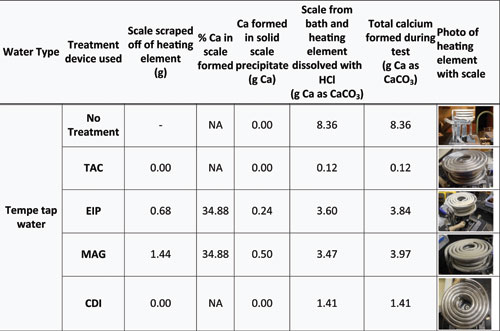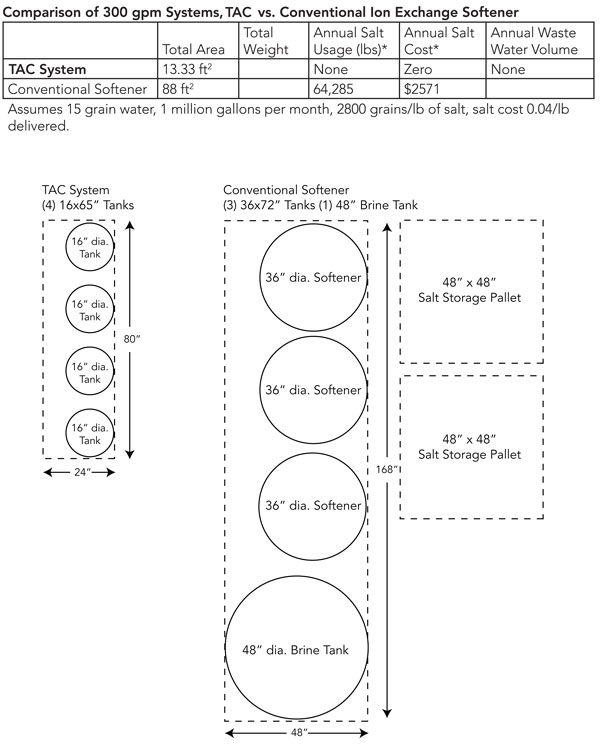Template-Assisted Crystallization
Scale formation is not static (it is constantly forming and dissolving). The existence of continuously generated seed crystals not only eliminates further deposition of scale on water contact surfaces but in fact will cause deposited scale to gradually dissolve back into the water and deposit on passing seed crystals in the water (from contact surfaces to solution to seed crystals). This means that not only are TAC water conditioning units good for new construction, these systems can also help alleviate scale problems in existing buildings including historic structures. When using TAC in new construction, Reyneke recommends that new copper piping should be allowed to cure or oxidize for a minimum of four weeks before turning on the water conditioner. This prevents the leaching of copper from the new pipes which can damage the TAC media. Water quality evaluation and treatment options for complex mechanical systems may require assistance from manufacturers who can design the TAC interface as required.

Chart courtesy of Arizona State University study April 26, 2011
As shown on the chart, results from current research demonstrate that TAC is the most effective water conditioning system for the reduction of scale.
Research to Set Environmental Benchmarks
The University of Arizona, along with HDR Engineering Inc. conducted a recent research study sponsored by the WateReuse Foundation that evaluated alternatives to domestic ion exchange water softeners.4 The participants of the study included the California cities of Hollister, Los Angeles, and Santa Clara County and water samples were also tested in Arizona cities including Phoenix, Tucson and Scottsdale. The goal of the study is to review technologies that would provide consumers with the ability to reduce the impacts of hard water without creating the negative impacts of salt and brine backwashes into the environment. It also developed and used testing methodology based on German standards to set metrics for the measurement of the effectiveness of scale prevention. The study was commissioned because of the urgency of the problem of poor water quality in freshwater resources. More and more communities have struggled with the cost and environmental impacts of the rising concentration of TDS and associated ions and salts in wastewater collected and received at water reclamation facilities.
Presently, there are no ANSI or NSF standards for testing water quality and scaling. The German Society of Gas and Water Specialists (DVGW), which regulates water quality in Germany, developed a protocol that measures anti-scaling of water conditioning devices.5 The Arizona study used a testing protocol based on the DVGW W512 test to assess the control of scale formation. The process was to pump 130 L/d of water through an electronically heated 10-L reservoir for 20 days. After the test was completed, researchers determined the quantity of scale formed on the heating element and the reservoir. Baselines were set for certification of conditioners for the prevention of scale. The study evaluated several no-salt alternatives to ion exchange and measured the mechanisms and effect on these physical water treatment (PWT) systems to the accumulation of scale. These systems included:
- Capacitive Deionization (CDI)
- Electrically Induced Precipitation (EIP)
- Electromagnetic Water Treatment (MAG)
- Template-Assisted Crystallization (TAC)

Photo courtesy of Watts
Template-assisted crystallization water conditioning systems use a process similar to biomineralization creating "soft" scale crystals that do not attach to plumbing components, or mechanical equipment.
The most familiar PWT devices operate either through magnetic or electronic fields but according to the latest studies, TAC devices are the only product that meets and exceeds the latest measurement standards. Although there was a significant reduction in scale for all PWT devices, the scale prevention of the template-assisted crystallization device excelled and performed substantially better than all of the others.
Improving Water Quality in Cities
According to Steven Solomon in Water, The Epic Struggle of Wealth, Power and Civilization,6 earth as the water planet is like humans, comprised of about 70 percent water. Because of the nature of the hydrologic cycle, the water on earth is a constant quantity, however, the quality of water has been greatly impacted by humans and drinking water is a nonrenewable resource. He outlines the intense and interrelated ways that water is used by humans for drinking, cooking, sanitation, agriculture, industry, mining, power, transportation and of “growing prominence today, environmentally to sustain vital ecosystems against natural and man-made depletions and degradations.” According to Solomon, “The secret of water's extraordinary potency to transform history was that whenever a society, in its constant struggle to wrench a surplus from nature, was able to innovate to make its water resources more manageable, abundant, potable or navigable, it...unlocked and harnessed more of water's inherent, often hidden catalytic potential for growth.”7
Across the world, protecting water resources and improving water quality has become a major political and strategic focus. Fresh water and treated water is a miraculous combination of minerals, nutrients and chemicals that give life on this planet. Aquifers, wells, rainwater, water trapped and treated in sewage plants can provide both helpful and harmful nutrients depending on the composition of the water chemistry. Water, as many pundits have stated, is the next oil crisis. The lack of fresh water resources needed to fuel humans, agriculture and industry is under scrutiny by citizens and politicians. Water conditioning that adds harmful salt brine to the water system only adds to the problems of poor water quality. If humans are the enemy of fresh water resources, they must also be the source of the solution through applied knowledge, invention and action.
Water conservation is also a major environmental issue when designing a sustainable building. Using TAC conserves water while increasing energy efficiency. The use of a template-assisted crystallization conditioner is part of a smart, 21st century, integrated environmental strategy for water use in buildings.

Photo courtesy of Watts
Diagram comparing size of TAC units to conventional softeners with salt storage.
Endnotes
- http://www.wqa.org/detergent/SWB_Studies.pdf
- http://water.usgs.gov/owq/hardness-alkalinity.html
- http://water.epa.gov/drink/local/index.cfm
- http://www.usbr.gov/research/AWT/WateReuse/WateReuse_research.html
- http://www.wcponline.com/pdf/0702Tech%20Talk.pdf
- Solomen, Steven. Water, The Epic Struggle for Wealth, Power and Civilization. Harper Perennial, N.Y., 2011.
- Solomen, p.18.
Architect Celeste Allen Novak, AIA, LEED AP, specializes in sustainable design and planning in Ann Arbor, Michigan.
 |
| Watts is a global leader in the design and manufacture of innovative water solutions for residential, commercial and institutional environments. Products include an extensive line of flow control, filtration and treatment products for water quality, and residential plumbing & heating. Founded in 1874, Watts is headquartered in North Andover, MA. www.watts.com |








